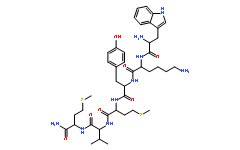| Cas No.: | 187986-17-0 |
| Chemical Name: | D-Methioninamide,L-tryptophyl-L-lysyl-L-tyrosyl-L-methionyl-L-valyl- |
| SMILES: | NCCCCC(NC(=O)C(N)CC1C2C(=CC=CC=2)NC=1)C(=O)NC(CC3=CC=C(O)C=C3)C(=O)NC(CCSC)C(=O)NC(C(C)C)C(=O)NC(CCSC)C(N)=O |
| Formula: | C41H61N9O7S2 |
| M.Wt: | 856.11 |
| Purity: | >98% |
| Sotrage: | 2 years -20°C Powder, 2 weeks4°C in DMSO,6 months-80°C in DMSO |
| Publication: | Bae et al (2002) The synthetic chemoattractant peptide, Trp-Lys-Tyr-Met-Val-D-Met, enhances monocyte survival via PKC-dependent Akt activation. J.Leukoc.Biol. 71 329 PMID: 11818455 Christophe et al (2001) The synthetic peptide Trp-Lys-Tyr-Met-Val-Met-NH2 specifically activates neutrophils through FPRL1/Lipoxin A4 receptors and is an agonist for the orphan monocyte-expressed chemoattractant receptor FPRL2. J.Biol.Chem. 276 21585 PMID: 11285256 Le et al (1999) Utilization of two seven-transmembrane, G protein-coupled receptors, formyl peptide receptor-like 1 and fomyl peptide receptor, by the synthetic hexapeptide WKYMVm for human phagocyte activation. J.Immunol. 163 6777 PMID: 10586077 |
| Description: | WKYMVM is a potent N-formyl peptide receptor (FPR1) and FPRL1/2 agonist, also activates several leukocyte effector functions such as chemotaxis, mobilization of complement receptor-3, and activation of the NADPH oxidase[1][2]. |
| Target: | FPR1, FPRL1[1], FPRL2[2] |
| References: | [1]. Christophe T, et al. The synthetic peptide Trp-Lys-Tyr-Met-Val-Met-NH2 specifically activates neutrophils through FPRL1/lipoxin A4 receptors and is an agonist for the orphan monocyte-expressed chemoattractant receptor FPRL2. J Biol Chem. 2001 Jun 15;276(24):21585-93. [2]. Christophe T, et al. Phagocyte activation by Trp-Lys-Tyr-Met-Val-Met, acting through FPRL1/LXA4R, is not affected by lipoxin A4. Scand J Immunol. 2002 Nov;56(5):470-6. |

 To enhance service speed and avoid tariff delays, we've opened a US warehouse. All US orders ship directly from our US facility.
To enhance service speed and avoid tariff delays, we've opened a US warehouse. All US orders ship directly from our US facility.




















